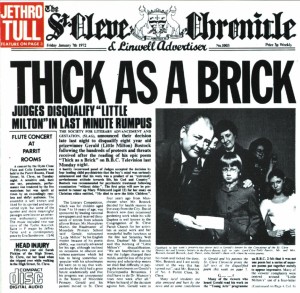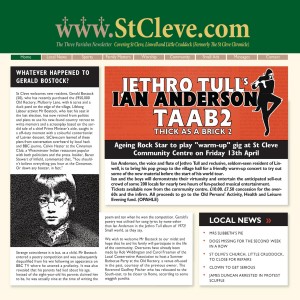Riffs, Rants and Rumors: Getting Thicker Than a Brick With Ian Anderson
posted in: Features • Rock
 It’s 1972. The Godfather is inaugurating America’s obsession with the inner lives of Mafiosi. Hunter S. Thompson chronicles the dreams of the ’60s turning sour in Fear and Loathing in Las Vegas. Meanwhile, over in England, Ian Anderson and his chums in Jethro Tull are cementing their status as prog-rock legends by following the previous year’s Aqualung album with the conceptual meisterwerk that is Thick As A Brick. According to Anderson, who is currently preparing for a multi-tiered celebration of the latter milestone’s fortieth birthday, TAAB was actually conceived mostly as a satirical response to the media’s rampant misinterpretations of Aqualung as a concept album. “I thought it would be fun to do a concept album that was such a huge step into the improbable,” says Anderson, “a slightly surreal and satirical look at concept albums, so that’s what I did.”
It’s 1972. The Godfather is inaugurating America’s obsession with the inner lives of Mafiosi. Hunter S. Thompson chronicles the dreams of the ’60s turning sour in Fear and Loathing in Las Vegas. Meanwhile, over in England, Ian Anderson and his chums in Jethro Tull are cementing their status as prog-rock legends by following the previous year’s Aqualung album with the conceptual meisterwerk that is Thick As A Brick. According to Anderson, who is currently preparing for a multi-tiered celebration of the latter milestone’s fortieth birthday, TAAB was actually conceived mostly as a satirical response to the media’s rampant misinterpretations of Aqualung as a concept album. “I thought it would be fun to do a concept album that was such a huge step into the improbable,” says Anderson, “a slightly surreal and satirical look at concept albums, so that’s what I did.”
 Prog rock was in full flower at the time”1971 had seen the release of such watershed albums as Yes‘s Fragile and Genesis‘s Nursery Cryme”but Anderson was never one to remove his tongue entirely from his cheek. “Yes or early Genesis or Emerson, Lake and Palmer, I suppose those would be the classic examples of our peers who, in a way, I was gently lampooning,” he says of his concept-rock satire, “But it was just a fashionable period of time for concept albums. By ’72 I think quite a few people were at it, doing that kind of grand-scale work, and I just thought I’d try to take it a step further.” Of course, Thick As A Brick represented much more than just the Spinal Tap of its day”containing one continuous, album-length piece of music, the record is a full-fledged song suite, full of fascinating changes in mood, mode, tempo and time signature, with an evocative and coherent lyrical narrative running throughout. “Like anything that has some parody or satire, it also has an element of seriousness that lies behind it,” Anderson agrees, “I think that’s one of the important things you try to do if you’re a writer or a composer, you try to give it some other layers of meaning than the obvious one.”
Prog rock was in full flower at the time”1971 had seen the release of such watershed albums as Yes‘s Fragile and Genesis‘s Nursery Cryme”but Anderson was never one to remove his tongue entirely from his cheek. “Yes or early Genesis or Emerson, Lake and Palmer, I suppose those would be the classic examples of our peers who, in a way, I was gently lampooning,” he says of his concept-rock satire, “But it was just a fashionable period of time for concept albums. By ’72 I think quite a few people were at it, doing that kind of grand-scale work, and I just thought I’d try to take it a step further.” Of course, Thick As A Brick represented much more than just the Spinal Tap of its day”containing one continuous, album-length piece of music, the record is a full-fledged song suite, full of fascinating changes in mood, mode, tempo and time signature, with an evocative and coherent lyrical narrative running throughout. “Like anything that has some parody or satire, it also has an element of seriousness that lies behind it,” Anderson agrees, “I think that’s one of the important things you try to do if you’re a writer or a composer, you try to give it some other layers of meaning than the obvious one.”
In fact, TAAB marked the full musical maturation of the band, who had evolved from heavy-riffing blues-rockers to purveyors of complex jazz- and classical-influenced works. “When we began at the Marquee club in February of 1968, we were a little old blues band,” recalls Anderson. “That blues boom was very much in sharp focus at that point, and the only thing that made us stand out from the crowd was the fact that I played the flute. Blues and jazz and folk music”lots of things played a part in my musical influences, but at that point, in order to get a gig, we had to be a blues band.” Tull’s second album, 1969’s Benefit, began the evolutionary process that came to full fruition three years later with Thick As A Brick. “Stand Up brings together all those other elements that were my influences,” Anderson explains, “world music, Asian music, Mediterranean music, classical music, jazz, blues, folkie stuff, acoustic stuff” it’s a very eclectic album.”
Even in 1972, a single track extended over the length of an entire album was asking a lot of rock fans’ attention spans. “It was a complex piece of music and quite a big ask in terms of getting record buyers around the world to give it serious attention,” Anderson allows. “It did demand a bit of effort on the part of the listener to get to know it and to get to like it, because it wasn’t just a collection of conveniently ID’ed tracks.”
 So how did Anderson come around to the idea of crafting Thick As A Brick 2, the sequel to the band’s audacious 1972 effort? Surely it would have been easier to celebrate the original album’s fortieth anniversary by simply embarking on a tour where it would be performed in its entirety, no? “I think I wouldn’t have found it sufficiently challenging or absorbing to go back and do just the old album,” Anderson replies. “I really wanted to put a stamp on doing Thick As A Brick as part and parcel of a whole evening, with a new, set-in-2012 cousin to the original. That seemed like a worthy challenge, but simply to go out and do the original album from 1972 would have seemed a little bit too nostalgic, revisiting a time gone by, and my heart isn’t really in that, frankly. Doing it in conjunction with a new album gives it a whole new lease of life. I can see it as part of a two-hour concert on stage, where the old and the new come together in a meaningful way that I can tie together with all the theatrical and production aspects of the show, so it’s more of a challenge and much more rewarding to do both of those things together.”
So how did Anderson come around to the idea of crafting Thick As A Brick 2, the sequel to the band’s audacious 1972 effort? Surely it would have been easier to celebrate the original album’s fortieth anniversary by simply embarking on a tour where it would be performed in its entirety, no? “I think I wouldn’t have found it sufficiently challenging or absorbing to go back and do just the old album,” Anderson replies. “I really wanted to put a stamp on doing Thick As A Brick as part and parcel of a whole evening, with a new, set-in-2012 cousin to the original. That seemed like a worthy challenge, but simply to go out and do the original album from 1972 would have seemed a little bit too nostalgic, revisiting a time gone by, and my heart isn’t really in that, frankly. Doing it in conjunction with a new album gives it a whole new lease of life. I can see it as part of a two-hour concert on stage, where the old and the new come together in a meaningful way that I can tie together with all the theatrical and production aspects of the show, so it’s more of a challenge and much more rewarding to do both of those things together.”
As every Tull fan knows, TAAB was presented as the musical adaptation of a poem written by fictional, precocious eight-year-old Gerald “Little Milton” Bostock. It doesn’t take a Ph.D. in math to figure out that Gerald would be forty-eight in 2012, and Anderson decided to base Thick As A Brick 2 on the possible paths that the adult Gerald might have taken. Banker, preacher, suburbanite, loan shark, all are represented in their own sections of a fifty-four-minute piece that echoes its antecedent not only in theme, but in structure and style as well. While Jethro Tull undeniably adapted to changing times as the years moved on, modernizing their sound along the way, Thick As A Brick 2 quite rightly brings things back to the kind of classic prog feel found in the first installment. Even the small-town newspaper spoof that made up the original album cover finds its corollary here, although the St. Cleve Chronicle of 1972 has now, of course, become www.StCleve.com. It should be noted that while Jethro Tull does continue to tour today, TAAB 2 is not an official Tull project, but an Ian Anderson album. But then, Anderson and guitarist Martin Barre are the only Tull members remaining from the 1972 lineup anyhow, so it probably wouldn’t have made a giant deal of difference either way.
“The thing that always struck me as the most obvious choice was Gerald as a politician,” says Anderson when asked to envision the most likely modern-day outcome for the Bostock character, “but in a way, it was such an obvious one I decided to keep it just as a brief reference on the album cover, effectively the home page of StCleve.com, rather than write a song section about that particular scenario. I decided to pursue more varied possibilities. Still, my money would be on that sort of an outcome. I’m pretty sure he wouldn’t have been a hockey player or an astronaut. I did actually think about an astronaut”the trouble is, I actually know some astronauts, and if I’d written about Gerald as an astronaut I think I would have drawn on some aspects of what I know that would have probably rather betrayed confidences, and it’s not the thing to do.”
 And how does a nearly hour-long prog-rock conceptual piece play in the twenty-first century, with so much water under the bridge since the concept-album glory days of the ’70s? “One of the things that I had to face, obviously, with doing a new album that was a forty-years-later sequel set in the present day, I had to consider that we live in a different world now,” admits Anderson. “It’s CDs and not vinyl, so I did have to write and arrange the music in such a way that I could put in ID points that would allow people to get from section to section, even though it’s a continuous-flow piece of music. It doesn’t have any digital silence on it anywhere, one thing moves to the next. I couldn’t risk putting any total silence between bits, otherwise it would have spoiled the flow. It also has to be bundled on iTunes so people can buy individual bits, which we’re gonna have to do with the original Thick As A Brick album too in the next couple of months in preparation for its remix in September.” So has the man who mixed madrigals with rock during Jethro Tull’s heady heyday made peace with the present-day place of prog-rock epics? “It’s something I have to accept,” he admits, “people listen to music in a different way these days; they snack on music, they don’t sit down to a twelve-course banquet.”
And how does a nearly hour-long prog-rock conceptual piece play in the twenty-first century, with so much water under the bridge since the concept-album glory days of the ’70s? “One of the things that I had to face, obviously, with doing a new album that was a forty-years-later sequel set in the present day, I had to consider that we live in a different world now,” admits Anderson. “It’s CDs and not vinyl, so I did have to write and arrange the music in such a way that I could put in ID points that would allow people to get from section to section, even though it’s a continuous-flow piece of music. It doesn’t have any digital silence on it anywhere, one thing moves to the next. I couldn’t risk putting any total silence between bits, otherwise it would have spoiled the flow. It also has to be bundled on iTunes so people can buy individual bits, which we’re gonna have to do with the original Thick As A Brick album too in the next couple of months in preparation for its remix in September.” So has the man who mixed madrigals with rock during Jethro Tull’s heady heyday made peace with the present-day place of prog-rock epics? “It’s something I have to accept,” he admits, “people listen to music in a different way these days; they snack on music, they don’t sit down to a twelve-course banquet.”
Nevertheless, Anderson has taken full advantage of modern technology to give Bostock a further-reaching semblance of life than his eight-year-old self could ever have enjoyed. Gerald current has his own Facebook page and Twitter account, for instance. Newcomers to the tale might well assume that Bostock is as alive as Anderson himself. Was that sort of misconception ever a problem back in ’72? “I think in the UK, where the tradition of surreal British humor has been well established, they got the joke pretty quickly,” reckons Anderson, “but it maybe took a little longer in some other countries…maybe there are some people who never did. Maybe to this day there are people who think that Gerald Bostock is a real person.”
